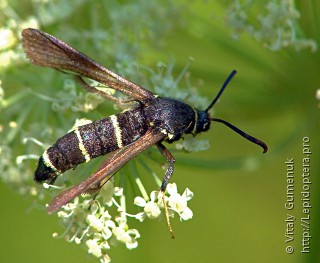Paranthrene tabaniformis
Taxonomy
class Insecta
Species name(s)
Paranthrene tabaniformis (Rottemburg, 1775) = Paranthrene annulifera Closs 1920 = Sphinx asiliformis Schiffermüller & Denis, 1776 = Sesia crabroniformis Laspeyres, 1801 = Paranthrene diaphana Schawerda 1921 = Paranthrene intermedia Le Cerf 1916 = Sesia kungessana Alphéraky, 1882 = Sesia rhingiaformis Duponchel, 1833 = Sphinx rhingiaeformis Hübner, 1789 = Sesia serratiformis Freyer, 1831/58 = Paranthrene synagriformis Rambur 1858 = Memythrus vespiformis Newman, 1832. [10, 187]
Dusky Clearwing.
urn:lsid:insecta.pro:taxonomy:2932
Expansion
This species marks on the maps: 1.
Zoogeographical regions
Palaearctic.
Russia regions
#3. Karelsky; #4. Evropeisky Severo-Zapadny; #7. Evropeisky yuzhno-tayozhny; #8. Evropeisky Tsentralny; #9. Evropeisky Tsentralno-Chernozyomny; #10. Sredne-Volzhsky; #11. Volgo-Donsky; #12. Nizhnevolzhsky; #13. Zapadno-Kavkazsky; #16. Sredne-Uralsky; #17. Yuzhno-Uralsky; #19. Sredneobsky; #20. Yuzhno-Zapadnosibirsky; #22. Krasnoyarsky; #23. Predaltaisky; #29. Zapadno-Yakutsky; #38. Sakhalin; #40. Primorsky.
Forewing length
18—20 mm.
Primary colors
Yellow, Blue, Brown/Gray/Black.
Flight time
| January | February | March | April | May | June | July | August | September | October | November | December |
Larva lifespan
| January | February | March | April | May | June | July | August | September | October | November | December |
Over-wintering stage
Larva.
Detailed information with references
Distribution
Imago Habitus and Differences from alike species
General info about Imago
Imago lifespan
General info about Larva
Larva food plants / other food objects
Larva lifespan
Overwintering stage
Subspecies of Paranthrene tabaniformis
- Paranthrene tabaniformis synagriformis (Rambur, 1866). [10]
- P. t. tabaniformis (Rottemburg, 1775). [10]
Authors
Initial species uploading to the site: Peter Khramov.
Text data: Peter Khramov.
The species characteristics formalization: Peter Khramov, Sergei Kotov.
References
- [1] O. Karsholt, J. Razowski (eds.), 1996. The Lepidoptera of Europe: a distributional checklist
- [3] Каталог чешуекрылых (Lepidoptera) России. Под ред. С. Ю. Синёва. СПб.; М.: Товарищество научных изданий КМК, 2008
- [5] Райххолф-Рим Х. Бабочки. М.: Астрель, 2002
- [10] de Jong, Y.S.D.M. (ed.) (2011) Fauna Europaea version 2.4 (faunaeur.org)
- [28] Moths and Butterflies of Europe and North Africa (leps.it), 2012
- [187] Species 2000, http://www.sp2000.org
Comments
Note: you should have a Insecta.pro account to upload new topics and comments. Please, create an account or log in to add comments
Paranthrene tabaniformis photos



All the photos of the species in large size
Please, create an account or log in to upload your photo



